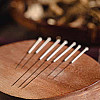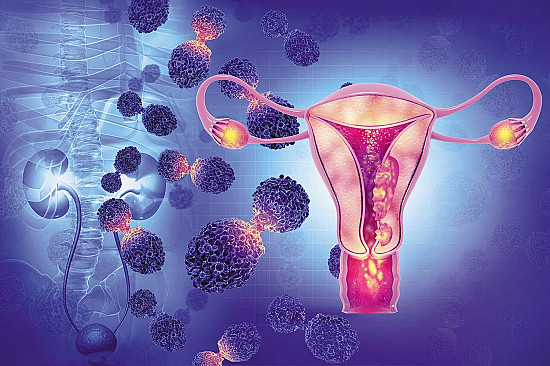Uterine and bladder prolapse
- Reviewed by Howard E. LeWine, MD, Chief Medical Editor, Harvard Health Publishing; Editorial Advisory Board Member, Harvard Health Publishing
What is it?
The uterus and the bladder are held in their normal positions just above the inside end of the vagina by a "hammock" made up of supportive muscles and ligaments. Wear and tear on these supportive structures in the pelvis can allow the bottom of the uterus, the floor of the bladder, or both to sag through the muscle and ligament layers.
When this occurs, the uterus or bladder can create a bulge into the vagina. In severe cases, it is possible for the sagging uterus or bladder to work its way down far enough that the bulge can appear at the vagina's opening or even protrude from the opening.
When the uterus sags downward, it is called uterine prolapse. When the bladder sags, it is called bladder prolapse, also known as a cystocele.
Various stresses can cause the pelvic muscles and ligaments to weaken and lead to uterine or bladder prolapse. The most significant stress on these muscles and ligaments is childbirth. Women who have had multiple pregnancies and vaginal delivery are more likely to develop prolapse.
Other stresses that can lead to prolapse include constipation with a habit of frequent straining to pass stool, and a chronic cough. Obesity also can strain the pelvic muscles.
Support problems in the pelvis become worse after menopause because the pelvic tissues depend on estrogen to help them keep their tone, and estrogen levels drop after menopause.
Some doctors estimate that half of all women have some degree of uterine or bladder prolapse in the years following childbirth. For most women, these conditions remain undiagnosed and untreated. Only 10% to 20% of women with pelvic prolapse seek medical evaluation for symptoms.
Symptoms
Mild cases of bladder or uterine prolapse usually don't cause any symptoms. A prolapse that is more advanced can cause any of the following symptoms:
- discomfort in the vagina, pelvis, lower abdomen, groin or lower back: The discomfort associated with prolapse often is described as a pulling or aching sensation. It can be worse during sexual intercourse or menstruation.
- heaviness or pressure in the vaginal area (some women feel like something is about to fall out of the vagina)
- a bulge of moist pink tissue from the vagina (this exposed tissue may be irritated and cause itching or small sores that can bleed)
- leakage of urine, which can be worse with heavy lifting, coughing, laughing, or sneezing
- frequent urination or a frequent urge to urinate
- recurrent urinary tract infections, because the bladder can't empty completely when you urinate
- a need to push your fingers into your vagina, into your rectum, or against the skin near your vagina to empty your bladder or have a bowel movement
- difficulty having a bowel movement
- pain with sexual intercourse, urine leakage during sex, or an inability to have an orgasm
- moist discharge that soils your undergarments.
Diagnosis
An experienced physician usually can diagnose uterine or bladder prolapse with a pelvic examination. Occasionally, an MRI (magnetic resonance imaging) test may be needed to confirm the diagnosis.
In some cases, especially if you are having recurrent urinary infections or if you are having difficulty holding your urine, your doctor may order one or more tests to evaluate your bladder function.
Urodynamic studies test your bladder function and can show if your bladder empties completely. The pressure inside your bladder is measured as fluid is passed into it through a small tube. An x-ray video taken after dye is inserted through your urethra to fill your bladder can show whether its shape is distorted. This test is known as a voiding cystourethrogram.
Expected duration
Sometimes you can reverse a mild case of prolapse by doing exercises that strengthen the pelvic muscles. In other cases, the degree and severity of the prolapse can increase over time as the woman ages. This can occur more rapidly in some women than in others.
Advanced or severe cases of prolapse usually do not respond to exercise or hormonal therapy. Surgery often improves or cures pelvic organ prolapse.
Prevention
You can take some simple steps to limit stress on the pelvic support system, especially if you have given birth. Limit heavy lifting and avoid unnecessary straining to have bowel movements. Avoid smoking so that you have a lower risk of chronic cough. Maintain a normal body weight through diet and exercise.
Estrogen supplements after menopause have been credited with helping to maintain strong pelvic muscles and ligaments, but there is no strong evidence that hormone replacement medicine after menopause prevents or treats a bladder or uterine prolapse. There are known health risks associated with hormone replacement. If you are interested in taking hormone replacement medication, you should review the pros and cons of this treatment with your physician.
Treatment
For mild cases, measures to strengthen pelvic floor muscles may be enough to limit symptoms of prolapse. Exercises known as Kegel exercises are an excellent way to increase your pelvic support.
To perform Kegel exercises, squeeze the muscles you would use to prevent yourself from passing urine or gas. Hold the contraction for a few seconds, then release. Make sure to completely relax your pelvic floor muscles after the contraction. Repeat 10 times. Try to do four to five sets a day.
Over time, most women notice improvement in bladder control and may have less pain or fewer symptoms.
A physician can fit a rubbery, ring-shaped device called a pessary into the upper portion of your vagina. Pessaries can help to prop up the uterus and bladder and prevent them from sagging into the vagina. They are removable so they can be washed periodically.
A prolapsed bladder or uterus may need to be corrected with surgery, which can be done through the vagina, an incision in the abdomen, or by laparoscopy. The procedure that is chosen depends on the woman's age, severity of the symptoms, medical history, desire for future fertility, and desire to be able to have sex. The goals are to restore normal anatomy, relieve symptoms, restore normal bowel and bladder function, and restore the ability to have sex. In some cases, surgical removal of the uterus (hysterectomy) is recommended.
When to call a professional
Prolapse of the pelvic organs is generally a nonthreatening problem. You should contact your physician for an evaluation if you are having bothersome symptoms and you suspect you might have this problem. It is also important to report changes in urinary symptoms to your doctor, since urinary infections are a possible complication of prolapse.
Prognosis
Minor prolapse of the uterus or bladder can be corrected with strengthening exercises of the pelvic floor muscles. Once prolapse has progressed to a more advanced stage, it will continue and worsen without surgical treatment or pessary support.
Mild to moderate prolapse is unlikely to cause significant medical consequences and may not require treatment. Advanced, severe, or complete prolapse usually requires pessary support or surgical treatment to minimize problems with urinary incontinence, urinary retention, vaginal ulceration, sexual dysfunction, or difficulties with having a bowel movement.
Additional info
American College of Obstetricians and Gynecologists
https://www.acog.org/
Society of Gynecologic Surgeons
https://www.sgsonline.org/
American Urogynecologic Society
https://www.augs.org/
About the Reviewer

Howard E. LeWine, MD, Chief Medical Editor, Harvard Health Publishing; Editorial Advisory Board Member, Harvard Health Publishing
Disclaimer:
As a service to our readers, Harvard Health Publishing provides access to our library of archived content. Please note the date of last review or update on all articles.
No content on this site, regardless of date, should ever be used as a substitute for direct medical advice from your doctor or other qualified clinician.















